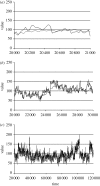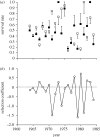Fluctuating selection: the perpetual renewal of adaptation in variable environments
- PMID: 20008388
- PMCID: PMC2842698
- DOI: 10.1098/rstb.2009.0150
Fluctuating selection: the perpetual renewal of adaptation in variable environments
Abstract
Darwin insisted that evolutionary change occurs very slowly over long periods of time, and this gradualist view was accepted by his supporters and incorporated into the infinitesimal model of quantitative genetics developed by R. A. Fisher and others. It dominated the first century of evolutionary biology, but has been challenged in more recent years both by field surveys demonstrating strong selection in natural populations and by quantitative trait loci and genomic studies, indicating that adaptation is often attributable to mutations in a few genes. The prevalence of strong selection seems inconsistent, however, with the high heritability often observed in natural populations, and with the claim that the amount of morphological change in contemporary and fossil lineages is independent of elapsed time. I argue that these discrepancies are resolved by realistic accounts of environmental and evolutionary changes. First, the physical and biotic environment varies on all time-scales, leading to an indefinite increase in environmental variance over time. Secondly, the intensity and direction of natural selection are also likely to fluctuate over time, leading to an indefinite increase in phenotypic variance in any given evolving lineage. Finally, detailed long-term studies of selection in natural populations demonstrate that selection often changes in direction. I conclude that the traditional gradualist scheme of weak selection acting on polygenic variation should be supplemented by the view that adaptation is often based on oligogenic variation exposed to commonplace, strong, fluctuating natural selection.
Figures



References
-
- Abzhanov A., Protas M., Grant B. R., Grant P. R., Tabin C. J.2004Bmp4 and morphological variation of beaks in Darwin's finches. Science 305, 1462–1465 (doi:10.1126/science.1098095) - DOI - PubMed
-
- Arthur W., Phillips D., Mitchell P.1993Long-term stability of morph frequency and species distribution in a sand-dune colony of Cepaea. Proc. R. Soc. Lond. B 251, 159–163 (doi:10.1098/rspb.1993.0023) - DOI
-
- Barnett S. A.1958A century of Darwin Cambridge, MA: Harvard University Press
-
- Barrett R. D. H., MacLean R. C., Bell G.2005Experimental evolution of Pseudomonas fluorescens in simple and complex environments. Am. Nat. 166, 470–480 (doi:10.1086/444440) - DOI - PubMed
-
- Barrett R. D. H., MacLean R. C., Bell G.2006Mutations of intermediate effect are responsible for adaptation in evolving Pseudomonas fluorescens populations. Biol. Lett. 2, 236–238 (doi:10.1098/rsbl.2006.0439) - DOI - PMC - PubMed
Publication types
MeSH terms
LinkOut - more resources
Full Text Sources

